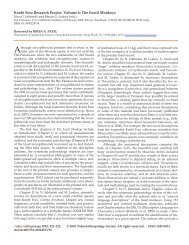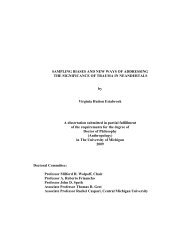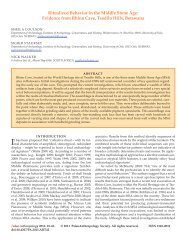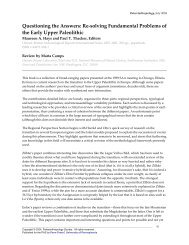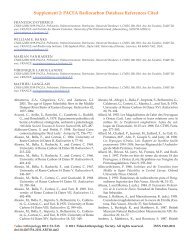Transitions in Prehistory: Essays in Honor of Ofer Bar-Yosef
Transitions in Prehistory: Essays in Honor of Ofer Bar-Yosef
Transitions in Prehistory: Essays in Honor of Ofer Bar-Yosef
Create successful ePaper yourself
Turn your PDF publications into a flip-book with our unique Google optimized e-Paper software.
<strong>Transitions</strong> <strong>in</strong> <strong>Prehistory</strong>: <strong>Essays</strong> <strong>in</strong> <strong>Honor</strong> <strong>of</strong> <strong>Ofer</strong> <strong>Bar</strong>-<strong>Yosef</strong><br />
John J. Shea and Daniel E. Lieberman (eds.)<br />
Oakville, CT: Oxbow Books, 2009, 498 pp. (hardback), $35.00.<br />
ISBN-13: 978842173404.<br />
Reviewed by MARLIZE LOMBARD<br />
Department <strong>of</strong> Anthropology and Devleopment Studies, University <strong>of</strong> Johannesburg, PO Box 524, Auckland Park, Johannesburg 2006, SOUTH<br />
AFRICA; marlize.lombard@gmail.com<br />
John Shea and Daniel Lieberman brought this landmark<br />
volume together to celebrate the lifework <strong>of</strong> <strong>Ofer</strong> <strong>Bar</strong>-<br />
<strong>Yosef</strong>. It reflects his wide range <strong>of</strong> research <strong>in</strong>terests, and<br />
his career as archaeologist that spanned several decades,<br />
and cont<strong>in</strong>ents. Yet, the editors are correct <strong>in</strong> their claim<br />
that there is little <strong>in</strong> the volume that can be considered a<br />
eulogy for a still active career. ‘<strong>Transitions</strong> <strong>in</strong> prehistory’ is a<br />
recurr<strong>in</strong>g theme <strong>in</strong> <strong>Ofer</strong> <strong>Bar</strong>-<strong>Yosef</strong>’s body <strong>of</strong> work. For this<br />
reason, the contributions from collaborators and students<br />
focus ma<strong>in</strong>ly on differences between chronologically sequential<br />
archaeological and/or paleontological assemblages.<br />
The 22 papers are assembled <strong>in</strong> three, loosely related<br />
and sometimes overlapp<strong>in</strong>g, thematic groups: 1) transitions<br />
<strong>in</strong> the Pleistocene, 2) transitions <strong>in</strong> the Holocene, and<br />
3) methodological and theoretical transitions.<br />
In the first paper Daniel Lieberman, David Pilbeam,<br />
and Richard Wrangham tackle the transition from Australopithecus<br />
to Homo <strong>in</strong> the typical ‘Harvard-dogma.’ They<br />
attempt to <strong>in</strong>tegrate the fossil and archaeological evidence,<br />
comb<strong>in</strong><strong>in</strong>g it with what they call ‘reasonable conjectures,’<br />
to consider selective processes that might have favored the<br />
transition. In short, they assume the transition depended<br />
on a new strategy for acquir<strong>in</strong>g and us<strong>in</strong>g energy <strong>in</strong> open<br />
habitats. M<strong>in</strong>dful <strong>of</strong> the lack <strong>of</strong> data available to test their<br />
model, they hope it to be a catalyst for further speculation.<br />
Leav<strong>in</strong>g the expansive African landscape, we are <strong>in</strong>troduced<br />
to the Hula Bas<strong>in</strong> <strong>in</strong> northern Israel. Craig Fibel,<br />
Naama Goren-Inbar, and Mitia Frum<strong>in</strong> present historical<br />
records on long-term landscape evolution <strong>in</strong> this region—<br />
known for its hom<strong>in</strong><strong>in</strong> occupations dur<strong>in</strong>g the Acheulean,<br />
Mousterian, Upper Paleolithic, and Epipaleolithic. Their<br />
approach allows further understand<strong>in</strong>g <strong>of</strong> landscape diversity<br />
and dynamics. It demonstrates how the Hula landscape<br />
responded to natural environmental dynamics, and<br />
small changes <strong>in</strong>troduced by humans, and suggests that<br />
the historical approach can be useful for reconstruct<strong>in</strong>g aspects<br />
<strong>of</strong> the paleoenvironment relat<strong>in</strong>g to prehistoric occupations.<br />
In her paper, ‘The wisdom <strong>of</strong> the aged and Out <strong>of</strong> Africa<br />
1’, Martha Tappen considers a series <strong>of</strong> hypotheses that<br />
h<strong>in</strong>ge on the evidence preserved and identified at Dmanisi,<br />
Georgia. She rema<strong>in</strong>s unconv<strong>in</strong>ced <strong>of</strong> climatic explanations<br />
for the northward spread <strong>of</strong> African biomes, and does not<br />
consider the bra<strong>in</strong> or body size <strong>of</strong> the Dmanisi specimens<br />
a stepwise change. Rather, she suggests that they had primary/early<br />
access to animal carcasses, and more <strong>in</strong>dividuals<br />
survived <strong>in</strong>to old age, <strong>in</strong>creas<strong>in</strong>g population growth,<br />
group cohesion, and knowledge accumulation.<br />
Steven Kuhn explores the widespread and long-last<strong>in</strong>g<br />
complex adaptive systems represented by the archaeological<br />
record <strong>of</strong> the Middle Paleolithic. He envisages that<br />
Middle Paleolithic hom<strong>in</strong><strong>in</strong>s responded to the demands <strong>of</strong><br />
‘large-animal-focused economies’ through social means<br />
and adjust<strong>in</strong>g patterns <strong>of</strong> cooperation, <strong>in</strong>stead <strong>of</strong> through<br />
technological change. This <strong>in</strong>terpretation, and his rejection<br />
<strong>of</strong> the ‘gradual accretion <strong>of</strong> technological knowledge’<br />
model, may have implications for how we view differential<br />
technological elaboration amongst contemporary Middle<br />
Stone Age populations <strong>in</strong> Africa or later Upper Paleolithic<br />
groups. In a logical follow-up, John Shea ‘bridges the gap’<br />
by exam<strong>in</strong><strong>in</strong>g behavioral changes among Homo sapiens<br />
populations across the Middle-Upper Paleolithic transition<br />
<strong>in</strong> the east Mediterranean Levant. He proposes a new hypothesis<br />
where differences <strong>in</strong> settlement, subsistence, technological<br />
organization, and sociality orig<strong>in</strong>ated <strong>in</strong> <strong>in</strong>tensified,<br />
<strong>in</strong>tra-specific competition among African Homo sapiens<br />
populations after ~75 ka. Accord<strong>in</strong>g to him, these populations<br />
spread <strong>in</strong>to the Levant after ~45 ka, br<strong>in</strong>g<strong>in</strong>g with<br />
them essential, species-specific adaptive strategies. Boldly,<br />
he provides ways to prove him wrong—stimulat<strong>in</strong>g further<br />
research. Mary St<strong>in</strong>er uses evidence from faunal mortality<br />
patterns to <strong>in</strong>vestigate the antiquity <strong>of</strong> large-game hunt<strong>in</strong>g<br />
<strong>in</strong> the Mediterranean Paleolithic. She focuses on prey age<br />
selection, suggest<strong>in</strong>g it lends credence to the idea <strong>of</strong> radical<br />
shifts <strong>in</strong> human ecology dur<strong>in</strong>g the late Epipaleolithic,<br />
perhaps result<strong>in</strong>g <strong>in</strong> the demise <strong>of</strong> Paleolithic hunt<strong>in</strong>g and<br />
gather<strong>in</strong>g lifeways <strong>in</strong> some areas.<br />
In the seventh paper <strong>of</strong> the volume, Radu Ioviţă re-evaluates<br />
connections between the Early Upper Paleolithic <strong>of</strong><br />
northeast Africa and the Levant. He assesses technological<br />
differences between Dabban and Emiran assemblages from<br />
Haua Fteah and Ksar ‘Akil, pos<strong>in</strong>g two questions. First, can<br />
either <strong>of</strong> the two sites be recognized as a source for technological<br />
development <strong>in</strong> the other? Secondly, do similarities<br />
warrant assum<strong>in</strong>g a migration from one place to another?<br />
In both cases, the evidence does not seem to support the<br />
hypotheses. Despite a relative simple picture <strong>of</strong> population<br />
movements, the cultural landscape appears more complex.<br />
Mov<strong>in</strong>g eastward, Daniel Adler explores cultural, behavioral,<br />
and biological discont<strong>in</strong>uities at the Middle-Upper<br />
Paleolithic transition <strong>in</strong> the southern Caucasus. He shows<br />
that, between ~38–34 ka, the region experienced a replacement<br />
event <strong>in</strong> which its traditional <strong>in</strong>habitants, the Nean-<br />
PaleoAnthropology 2010: 203−205. © 2010 PaleoAnthropology Society. All rights reserved. ISSN 1545-0031<br />
doi:10.4207/PA.2010.REV88
derthals, disappeared <strong>in</strong> the face <strong>of</strong> expand<strong>in</strong>g modern human<br />
populations. Neanderthal-modern human coexistence<br />
was, therefore, short-lived <strong>in</strong> the region. The major evolutionary<br />
edge, allow<strong>in</strong>g modern populations to grow at the<br />
expense <strong>of</strong> Neanderthals, is <strong>in</strong>terpreted as a cultural one—<br />
their ability to establish larger extended social networks<br />
and to exploit larger territories. Gilbert Tostev<strong>in</strong> chose to<br />
emphasize the importance <strong>of</strong> process and historical event<br />
(as epistemologically valid method suitable to the dataset)<br />
<strong>in</strong> the study <strong>of</strong> the Middle-Upper Paleolithic transition. He<br />
argues that this dual approach can be tapered from a regional<br />
scale to that <strong>of</strong> the smallest units <strong>of</strong> contextual association—the<br />
artifact assemblage. Furthermore, he suggests<br />
the approach can help <strong>in</strong>vestigate what made modern humans<br />
different enough from Neanderthals so that the former<br />
survived the Pleistocene while the latter did not.<br />
In a succ<strong>in</strong>ct, yet comprehensive overview (with many<br />
<strong>in</strong>formative maps) Nigel Gor<strong>in</strong>g-Morris, Erella Hovers,<br />
and Anna Belfer-Cohen discuss the dynamics <strong>of</strong> Pleistocene<br />
and Early Holocene settlement patterns and human<br />
adaptations <strong>in</strong> the Levant. The emerg<strong>in</strong>g picture h<strong>in</strong>ts at<br />
more complex and dynamic patterns and relationships between<br />
dispers<strong>in</strong>g, migrant, and local endemic groups than<br />
generally understood. The authors propose that, given<br />
the <strong>in</strong>evitable complexity <strong>of</strong> human survival and adaptations<br />
throughout the Pleistocene, it is not surpris<strong>in</strong>g that<br />
agriculture first emerged <strong>in</strong> this region. Shift<strong>in</strong>g our focus<br />
from the Old World to Sahul, Nicola Stern explores the<br />
potential <strong>of</strong> the archaeological record <strong>of</strong> this southern region<br />
for decod<strong>in</strong>g behavioral and evolutionary transitions<br />
dur<strong>in</strong>g the Middle-Upper Paleolithic <strong>in</strong> Eurasia. She sees a<br />
mis<strong>in</strong>terpretation <strong>of</strong> the behavioral <strong>in</strong>formation, conta<strong>in</strong>ed<br />
<strong>in</strong> the Pleistocene record, as explanation for the perceived<br />
disparity between the fossil and archaeological records <strong>of</strong><br />
modern human orig<strong>in</strong>s. As possible solution she suggests:<br />
a) trac<strong>in</strong>g the development <strong>of</strong> cognition, b) understand<strong>in</strong>g<br />
the relationship between cognition and the material record,<br />
and c) understand<strong>in</strong>g how changes <strong>in</strong> cognition relate to<br />
behavioral and anatomical change.<br />
The paper by Cheryl Makarewicz and Noreen Tuross<br />
<strong>in</strong>troduces one <strong>of</strong> the earliest animal management strategies—fodder<br />
provision. They exam<strong>in</strong>e diachronic changes<br />
<strong>in</strong> goat fodder<strong>in</strong>g practices from the Late Pre-Pottery Neolithic<br />
B context at Basta, Jordan. Us<strong>in</strong>g multiple bone collagen<br />
isotopic analysis, <strong>in</strong>clud<strong>in</strong>g organic oxygen, the study<br />
shows that chang<strong>in</strong>g environmental conditions were not a<br />
contribut<strong>in</strong>g factor to shifts <strong>in</strong> goat bone collagen carbon<br />
and nitrogen isotopic values. They go on to suggest that<br />
organic oxygen isotopes, obta<strong>in</strong>ed from archaeological<br />
faunal collagen, may <strong>of</strong>fer a new approach to improve understand<strong>in</strong>g<br />
<strong>of</strong> prehistoric human diets and paleoenvironments.<br />
In a speculative paper François Valla looks at the<br />
Epipaleolithic and the Early Neolithic assemblages <strong>of</strong> two<br />
Levant<strong>in</strong>e sites, ʹEynan and Netiv Hagdud, ~10 ka. A structuralist<br />
approach is used to consider various aspects <strong>of</strong> the<br />
material culture, look<strong>in</strong>g for possible <strong>in</strong>teractions between<br />
the villagers and their relationship to the world they live<br />
<strong>in</strong>. The outcome suggests that more modifications occurred<br />
204 • PaleoAnthropology 2010<br />
<strong>in</strong> <strong>in</strong>teractions between people and their external world<br />
than <strong>in</strong> <strong>in</strong>ter-personal relations, and that changes appear<br />
to favor hierarchical rather than egalitarian <strong>in</strong>teraction.<br />
He surmises that this eventually leads to a new system <strong>of</strong><br />
self-identification based on ‘analogism’ <strong>in</strong> the process <strong>of</strong><br />
elaboration. <strong>Yosef</strong> Garf<strong>in</strong>kel provides the reader with a<br />
short, but clear, account <strong>of</strong> the material culture sequence<br />
for the transition from the Neolithic to the Chalcolithic <strong>in</strong><br />
the southern Levant. His periodization table and the provided<br />
radiometric dates are useful for situat<strong>in</strong>g this transition<br />
<strong>in</strong> time and space. Isaac Gilead follows up with a more<br />
detailed presentation, focus<strong>in</strong>g on the culture history <strong>of</strong> the<br />
Late Sixth-Fifth Millennium <strong>in</strong> the same region us<strong>in</strong>g typo-technological<br />
observations comb<strong>in</strong>ed with radiocarbon<br />
dates. He suggests that the Chalcolithic is strongly related<br />
to the Ghassulian Culture—featur<strong>in</strong>g copper metallurgy as<br />
an attribute—and that the transition between the Neolithic<br />
and the Chalcolithic took place dur<strong>in</strong>g one or two centuries<br />
before the Ghassulian started.<br />
The Mesolithic <strong>of</strong> the Aegean Bas<strong>in</strong> is the wide-rang<strong>in</strong>g<br />
focus <strong>of</strong> the paper by Janusz Kozłowski and Małgorzata<br />
Kaczanowska. They <strong>in</strong>vestigate the Pre-Neolithic settlement<br />
<strong>of</strong> the Aegean Islands and its role <strong>in</strong> the Neolithization<br />
<strong>of</strong> southern Europe, suggest<strong>in</strong>g that environmental<br />
changes and more opportunistic hunt<strong>in</strong>g strategies caused<br />
dim<strong>in</strong>ished mobility <strong>of</strong> population groups at the Pleistocene/Holocene<br />
boundary. This resulted <strong>in</strong> greater isolation<br />
<strong>of</strong> groups, especially <strong>in</strong> the Balkans where hermitic<br />
communities formed. Dur<strong>in</strong>g the Early Mesolithic these<br />
groups did not readily adopt general ‘European’ cultural<br />
and stylistic trends, but preserved Late Paleolithic stone<br />
knapp<strong>in</strong>g traditions. With Met<strong>in</strong> Eren, we enter the New<br />
World. He discusses Paleo<strong>in</strong>dian stability dur<strong>in</strong>g the Dryas<br />
<strong>in</strong> the North American Lower Great Lakes, ~11–10 ka.<br />
His data-loaded paper (pollen collected from 60 sites and<br />
archaeological data from over 30 sites) demonstrates that,<br />
even though it may be expected as a result <strong>of</strong> dramatic climate<br />
change dur<strong>in</strong>g the late Pleistocene, there is a lack <strong>of</strong><br />
major change <strong>in</strong> Paleo<strong>in</strong>dian behavioral/technological adaptations.<br />
“Diagenetic transformations: decipher<strong>in</strong>g the archaeological<br />
record <strong>of</strong> prehistoric caves” is a useful method paper by Steve<br />
We<strong>in</strong>er. He shows that, based on data obta<strong>in</strong>ed from sites<br />
such as Kebara and Hayonim, diagenetic processes can be<br />
highly variable and particularly severe <strong>in</strong> caves that are<br />
occupied by birds, bats, and other animals. Here the ma<strong>in</strong><br />
driv<strong>in</strong>g force, caus<strong>in</strong>g chemical alterations <strong>in</strong> the archaeological<br />
record, is the degradation <strong>of</strong> guano shortly after<br />
burial. Archaeologists are urged to understand site diagenetic<br />
transformations <strong>in</strong> order to assess the completeness <strong>of</strong><br />
a cave’s archaeological record. Stay<strong>in</strong>g with the theme <strong>of</strong><br />
soil science, Paul Goldberg, Liliane Meignen, and Carol<strong>in</strong>a<br />
Mallol demonstrate the importance <strong>of</strong> geoarchaeology and<br />
contextual analyses <strong>in</strong> the study <strong>of</strong> transitions and site formation<br />
processes. Geological analyses allow assessment <strong>of</strong><br />
whether the context is favorable or not for preserv<strong>in</strong>g the<br />
<strong>in</strong>tegrity <strong>of</strong> a given assemblage. However, results should<br />
ideally be complemented with contextual analyses <strong>of</strong> lithic
artifacts, such as the vertical distribution <strong>of</strong> refits. Thoughtprovok<strong>in</strong>gly,<br />
they illustrate that many so-called transitional<br />
levels at important archaeological sites are almost certa<strong>in</strong>ly<br />
the result <strong>of</strong> post-depositional processes.<br />
Lamberg-Karlovsky turns his critical gaze towards Vere<br />
Gordon Childe and the concept <strong>of</strong> revolution. Readers are<br />
provided with a historical and political review <strong>of</strong> the <strong>in</strong>tellectual<br />
framework that Childe promoted to understand the<br />
Neolithic and Urban Revolutions. He suggests that central<br />
to Childe’s framework <strong>of</strong> historical change were the concepts<br />
<strong>of</strong> ‘revolution, progress and rationality,’ put forward<br />
with<strong>in</strong> a (sometimes skewed) Marxist framework. He also<br />
warns <strong>of</strong> a new scepter haunt<strong>in</strong>g eastern Europe <strong>in</strong> the form<br />
<strong>of</strong> a ‘velvet revolution’—striv<strong>in</strong>g for a civil society beyond<br />
the reach <strong>of</strong> ‘authoritative concepts’ that shackles the human<br />
spirit. In his exploratory essay, “Pattern and technology:<br />
why the chaîne opératoire matters,” Michael Chazan wishes<br />
to develop the idea that ‘pattern’ underlies many aspects<br />
<strong>of</strong> human culture; <strong>in</strong>clud<strong>in</strong>g language, music, and technology.’<br />
He provides anecdotes about modern technology and<br />
ritual, and develops an argument for pattern be<strong>in</strong>g core to<br />
the concept <strong>of</strong> chaîne opératoire. F<strong>in</strong>ally, he expands the focus<br />
to show the role <strong>of</strong> pattern <strong>in</strong> language and music, and<br />
<strong>in</strong>troduces selected cognitive science literature, suggest<strong>in</strong>g<br />
potential relevance to the <strong>in</strong>terpretation <strong>of</strong> archaeologically<br />
visible technical actions. Aaron Stutz completes the volume<br />
with his comparative approach to the nature <strong>of</strong> transitions<br />
<strong>in</strong> the Stone Age. For him, transitions are essentially phase<br />
changes <strong>in</strong> the systems accord<strong>in</strong>g to which societies habitually<br />
extract energy from the environment and <strong>in</strong>vest it <strong>in</strong><br />
reproduction, growth, and ma<strong>in</strong>tenance. Thus, the study<br />
<strong>of</strong> prehistoric transitions facilitates a potentially important<br />
<strong>in</strong>terdiscipl<strong>in</strong>ary meet<strong>in</strong>g between evolutionary ecology<br />
and demography. He suggests high-resolution historical<br />
data, such as those available for the Industrial Revolution,<br />
may be helpful to evaluate models <strong>of</strong> <strong>in</strong>ter-generational<br />
transformation and family formation <strong>in</strong> some Stone Age<br />
BOOK REVIEW • 205<br />
populations, e.g., the Natufian. He admits the evaluation <strong>of</strong><br />
some predictions may be challeng<strong>in</strong>g us<strong>in</strong>g archaeological<br />
analysis, or even impossible to test, and that much work<br />
rema<strong>in</strong>s.<br />
Review<strong>in</strong>g an edited book with such a wide thematic<br />
range is always a challeng<strong>in</strong>g task. A s<strong>in</strong>gle review/er can<br />
seldom do justice to all the topics or authors represented,<br />
thus any omissions or emphases are subjective and do not<br />
automatically reflect highlights or shortcom<strong>in</strong>gs <strong>in</strong> the<br />
book. I aimed to provide a concise overview <strong>of</strong> what readers<br />
can expect between the sturdy covers, but critical reviews<br />
<strong>of</strong> all the papers were not possible. On the whole,<br />
I do not see the book as <strong>in</strong>tended for the casual reader.<br />
Rather, it is a decidedly scholarly work that cont<strong>in</strong>ues <strong>Ofer</strong><br />
<strong>Bar</strong>-<strong>Yosef</strong>’s tradition <strong>of</strong> empirical research and <strong>in</strong>vigorat<strong>in</strong>g<br />
debate. The geographical regions, form<strong>in</strong>g the various<br />
backdrops for the papers, are almost all hotspots for current<br />
research and discourse. It provides someth<strong>in</strong>g <strong>of</strong> <strong>in</strong>terest<br />
and/or value for archaeological theorists, paleoanthropologists,<br />
behavioral ecologists, zooarchaeologists, and stone<br />
tool specialists, to mention but a few. My ma<strong>in</strong> criticism is<br />
that, because the book consists <strong>of</strong> strongly <strong>in</strong>dividualistic<br />
papers (rather than <strong>in</strong>tegrated chapters), written by subject<br />
or discipl<strong>in</strong>e specialists, there are noticeable differences <strong>in</strong><br />
quality and quantity <strong>of</strong> data/image presentation, and <strong>in</strong> jargon<br />
and readability. From a general reader’s po<strong>in</strong>t <strong>of</strong> view,<br />
it could have benefited from some standardization, more<br />
overview maps, and possibly a glossary to clarify jargon<br />
and region/phase specific term<strong>in</strong>ology. Refresh<strong>in</strong>gly, and<br />
true to the editors’ promise (although un<strong>in</strong>tended), there is<br />
little or no fashionable postmodernism between the covers<br />
<strong>of</strong> this robust volume. Rather, the book mostly portrays a<br />
strong custom <strong>of</strong> respect for hard-won evidence. Although<br />
not an exhaustive survey <strong>of</strong> important transitions, it provides<br />
provocative ideas with current global relevance, for<br />
those <strong>in</strong>volved or <strong>in</strong>terested <strong>in</strong> the research <strong>of</strong> human prehistory.



